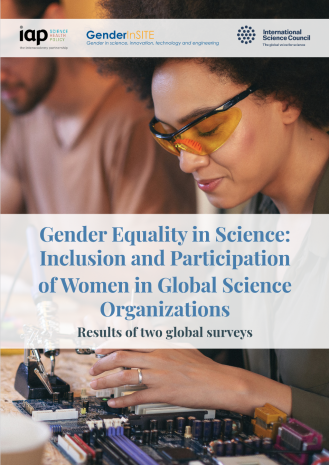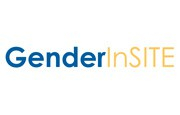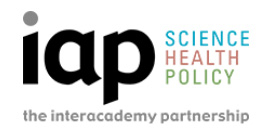Background
This study reports on the results of surveys conducted amongst academies that are members of the InterAcademy Partnership (IAP) and the International Science Council (ISC), as well as amongst international disciplinary unions and associations that are members of the ISC, to ascertain the inclusion and participation of women scientists. The study was coordinated by GenderInSITE (Gender in Science, Innovation, Technology and Engineering), in collaboration with the IAP and ISC. It is a follow-up to a first global survey of science academies conducted in 2015 and funded by the IAP. A key objective of the current study was to ascertain the extent to which progress in gender equality has been made by academies. What makes the present study unique is its broadened focus to include medical academies that became members of the IAP after 2015 and national young academies, as well as ISC-member academies, mainly drawn from the social sciences. In addition, the international disciplinary unions and associations of the ISC were also surveyed, given their potential to play an important role in leading gender transformation in specific disciplines.
Respectively, 85 and 38 valid submissions were received from the academies and the disciplinary unions and associations.
The individual science institutions surveyed, be they academies, disciplinary unions or associations, through their membership of international bodies such as the IAP and ISC, represent a large proportion of global scientific endeavour. In total, they represent over 250 unique organizations that are coordinated at a global level. The survey results therefore provide important baseline information for a transformative action agenda for gender equality in global science.
Survey of academies
Only six out of a total of 72 academies responded that the 2015 survey report, which contained many recommendations for academies, was discussed at a strategic planning session. This failing is addressed in the current report through a stronger and more directed recommendation to bring the results of the current survey to the attention of relevant academy governing bodies. Most appreciated of the previous report were the comparisons related to gender representation between academies. The comparisons were considered enlightening, provided useful statistics for reporting, and prompted both established and new academies into action.
The average share of women’s representation in 2020, across the same cohort of academies as in the 2015 survey, is 17%, up from 13% in the 2015 survey. If all senior academies that responded to the 2020 survey are included (26 more than in 2015), the average for women’s membership is 16%. All academies showed an increase in women’s membership, however, 19 academies still report 10% or less women’s membership. Academies of young scientists have the largest shares of women members, with the South African Young Academy of Science in the first position (57%), followed by both the Young Academy Finland and the National Academy of Young Scientists of Pakistan in joint second position (55% each). The average share of women’s membership of the 13 young academies is 42%. Ten young academies are ranked ahead of the highest ranked senior academy in terms of number of women members, viz. the Academy of Sciences of Cuba, which has increased its share from 27% in 2015 to 33% in 2020.
For each of nine broad disciplines, the mean share of women members ranges from as high as 28% (biological sciences) and 27% (social sciences, humanities and arts) to as low as 10% (engineering sciences) and 8% (mathematical sciences).
The average share of women serving on the governing body (29% for the 85 academies in 2020) represents an increase over the corresponding share of 21% for the academies that participated in the 2015 survey. Comparing the same cohort of 43 academies that participated in both the 2015 and 2020 surveys, the recent share is slightly lower at 28%. The National Academy of Sciences in the US (67%), together with Academia de Ciencias Físicas, Matemáticas y Naturales de Venezuela (67%) and the Global Young Academy (64%), have the highest representation of women serving on the governing body. This might be indicative of a concerted effort by some academies to involve more women in their governing body. It is noted that both the senior academies in the US and Venezuela have a woman president.
Asked whether the academy had any document (e.g. strategy, policy or founding document) that explicitly mentions the need for increased participation of women in the academy’s activities, 30 of the 84 academies (36%) responded in the affirmative. Twenty (24%) of the 84 academies responded that the academy hosts a ‘Women in Science’ award. Out of 84 academies, 21 (25%) indicated that, since 2015, they had published a report that specifically addresses issues related to women or gender. Nineteen of the 85 academies (22%) have a document of some kind that addresses sexual harassment in the workplace.
Asked if they have any programmes/initiatives on women in science, 39 (46%) of the 84 academies responded positively. The programmes and initiatives mentioned are wide-ranging. For some academies, the relevant programmes and initiatives are informed by their being the regional focal points and/or national chapters of global and regional organizations such as the Organization for Women in Science for the Developing World (OWSD), GenderInSITE and The World Academy of Sciences (TWAS). A few academies also established a commission for women in science, whereas, for others, relevant initiatives relate to the organization of specific events such as summits, international conferences and communication campaigns.
About 40% of academies address women’s issues through linkages with one or more international organization(s)/networks that promote(s) women’s activities. This is indeed the case for 13 of the 16 academies in the Americas but less so for Europe, where only seven of the 33 academies in that region reported that strategy. In the Americas, the strong focus of IANAS (Inter-American Network of Academies of Sciences), as a regional group, on women in science and their over 20-year history of undertaking gender-focused studies and advocacy, is significant.
Between 74% and 83% of academies either agreed or strongly agreed that their academy is working towards ensuring more women at decision-making levels, and in panels and committees. However, in terms of women’s representation in the nomination pool for membership as well as in the nomination pool for prizes and awards, the corresponding figures are lower at 62% and 61% respectively. Overall, the academies’ alignment with Sustainable Development Goal 5 (gender equality) of the United Nations is relatively low (46% agreed or strongly agreed, with an additional 20% stating that it does not apply to their academy). A similar finding pertains to the application of a ‘gender lens’ in the work of an academy (55% either agreed or strongly agreed that it is the case).
Survey of unions and associations
International unions and associations, collectively termed international disciplinary organizations in this report, have an average of 36% women serving on their governing bodies, and this share equals or exceeds 50% for 10 of the 38 disciplinary organizations. Generally, social science organizations are ranked higher in terms of the share of women on the governing body, 67% versus 24% for physical/natural science organizations.
Thirty-seven percent of international disciplinary organizations currently have a woman president and 39% currently have a woman occupying the position of executive director/secretary. Both these percentages have increased when compared with the immediate past percentages, viz. 32% in the case of president and 16% in the case of executive director/secretary.
Asked whether they have any document (strategy, policy, founding document, etc.) that explicitly mentions the need for increased participation by women in their activities, 31 disciplinary organizations responded. Of these, 14 (45%) responded in the affirmative. The documents differ in nature, ranging from strategic plans and mission statements to guidelines for support at scientific conferences and meetings.
Regarding attendance at their last General Assembly, 58% of disciplinary organizations reported that they did not collect gender/sex-disaggregated data for participants. Where such data were available, only in the case of 11% of disciplinary organizations did the percentage of women attendees at the General Assembly exceed 50%.
Twenty-one out of 33 disciplinary organizations (64%) responded that they had published a report that specifically addresses issues related to women or gender.
Disciplinary organizations with a secretariat were asked to indicate whether a policy exists for addressing sexual harassment in the workplace. Of 36 disciplinary organizations that responded, 15 (42%) pointed to the existence of such a policy.
Twelve out of 38 (32%) disciplinary organizations indicated that they have grants, fellowships or awards specifically for women. Nineteen out of 36 (53%) disciplinary organizations reported a committee, research board or similar structure with a specific focus on women in science issues. Twenty-two out of 37 (59%) disciplinary organizations reported an initiative and/or advocacy/networking activity aimed at the promotion of gender equality in science.
The disciplinary organizations’ commitment to diversity and inclusivity issues is high (68% agreement) but actions and activities are trailing far behind (32% agreement or below), with only 16% of disciplinary organizations reporting the availability of a budget to implement activities related to gender equality.
Only one disciplinary organization said that it has been evaluated on its performance and action to promote women’s participation and gender equality in science. Just over half of the 38 disciplinary organizations (20, or 53%) claimed that they regularly monitor women’s participation among their membership.
Recommendations
The individual organizations surveyed, be they academies, disciplinary unions or associations, through their membership of international bodies such as the IAP and ISC, represent a large proportion of the global scientific endeavour. In total, they represent over 250 unique organizations that are coordinated at a global level. The survey results therefore provide important baseline information for a transformative action agenda for gender equality in global science. Both the IAP and ISC are highly influential bodies; together they have the power to be forceful change-makers and leaders, with the potential to create a coalition for gender equality in global science. The recommendations that follow are crafted with such a coalition in mind and chart the way forward for an ongoing collaboration that can lead to meaningful transformation.
Recommendation 1: Extension of survey
A more inclusive and comprehensive understanding of gender equality in global science would be gained by supplementing the results of the current study with results of a survey (where such surveys have not been conducted) distributed to other global science organizations, such as the funding agencies of the Global Research Council (GRC), members of the World Federation of Engineering Organizations (WFEO) and engineering academies that are members of the International Council of Academies of Engineering and Technological Sciences (CAETS). Such an expansion would also serve to build and strengthen the nascent coalition for gender equality in global science.
Recommendation 2: Analysis of gender-related organizational policy, structure and actions
This study has gathered relevant information from the surveyed organizations and hence achieved an important first step in the creation of an inventory of policy documents and actions. The next step should be a detailed analysis of this rich and valuable set of resources with a view towards better understanding (1) the different models and modes associated with each of the three elements; (2) how organizations’ thinking around policy, structure and action has evolved; and (3) the identification of best practices in relation to gender and science, technology and innovation (STI).
Recommendation 3: Development of a central repository
There is an urgent need for the development and ongoing maintenance of a central repository of gender-related policies and actions (i.e. projects, interventions, outputs, etc.) of academies, disciplinary unions and associations. This has potential to establish closer linkages between organizations and presents opportunities to learn from each other’s best practices. Consideration should be given to the inclusion of evaluations of the efforts. The three partners in this project should discuss the nature of the proposed database, as well as hosting, funding and maintenance responsibilities.
Recommendation 4: Incorporation of regional considerations
Although the focus of this report is on global science organizations, each has a regional footprint that has highlighted some important regional variations, as well as regional shortcomings and opportunities. The regional networks, offices, or national committees present an opportunity to gain regional insights and to coordinate action directed at greater advocacy work amongst national science academies and national committees of disciplinary unions. The partners should develop a plan to utilize this regional presence and differential impacts to gain insights and to advance the gender equality agenda, especially in countries/regions that are lagging.
Recommendation 5: Advancing women to leadership positions
The average share of women serving on the governing body is 29% for academies and 37% for international disciplinary organizations. The three partners in this study should monitor and promote women’s leadership and service on governing bodies to ensure women’s voices are included in the setting of science agendas.
Recommendation 6: Consideration of diversity and inclusivity
The surveys explored the topics of diversity and inclusivity to gauge levels of awareness of these broader issues. It is concluded that it is best to follow a stepwise approach, whereby the focus on gender equality is retained into the future, while simultaneously raising awareness about the need for transformative action that embraces diversity and inclusivity more generally. The three partners should collaborate to foster a debate about diversity and inclusivity in global science, with a focus on intersectionality and gender considerations. Specific concerns relate to the intersection of race, ethnicity and gender. Organizations should take their cue for transformative action from the discussions.
Recommendation 7: Analysis of discipline-based gender transformation
This study has revealed that gender equality varies across disciplines, implying that discipline-based action is needed to increase the number of women researchers. The under-representation of women in certain disciplines presents a convergence point for the three partners to collaborate on a strategy to enhance not only the number of women researchers, but also the nomination pool of women and the success rate of women elected as members of science academies.
Recommendation 8: Establishment of monitoring and evaluation (M&E) frameworks
The finding that only six academies had discussed the recommendations of the 2015 academy report at a strategic planning session was disturbing and underscores the need for monitoring and evaluation (M&E). A strong recommendation of the 2015 report was for annual collection and reporting of gender-disaggregated data. Surveys should be conducted on a regular basis every five years. The IAP and ISC should commit to the establishment of centralized M&E frameworks that require regular reporting of relevant gender statistics of their member organizations at each of their general assemblies to ensure that gender transformation is tracked. They should also assist their members by providing tools for them to establish their own M&E frameworks.
Recommendation 9: Identification of lessons from young academies
This study has shown that young academies are significantly more gender-balanced than senior academies. The partners should undertake a follow-up collaborative study to understand how the gender transformation journey of senior academies can learn and benefit from the achievements of young academies in respect of gender balance and also to ensure that the balance is not lost as the careers of these young scientists advance and they begin to be nominated for senior academies and appointed to other leadership positions.
Recommendation 10: Shift from a focus on ‘numbers’ to institutional and knowledge transformation
The gender transformation journey of global science organizations needs to be about more than just ‘numbers’; it needs to focus in addition on institutional culture and knowledge production to ensure that the needs and perspectives of women as well as men are considered. The partners should embrace a shift from focusing on ‘numbers’ to an approach that embraces the incorporation of a ‘gender lens’ in all their activities.



